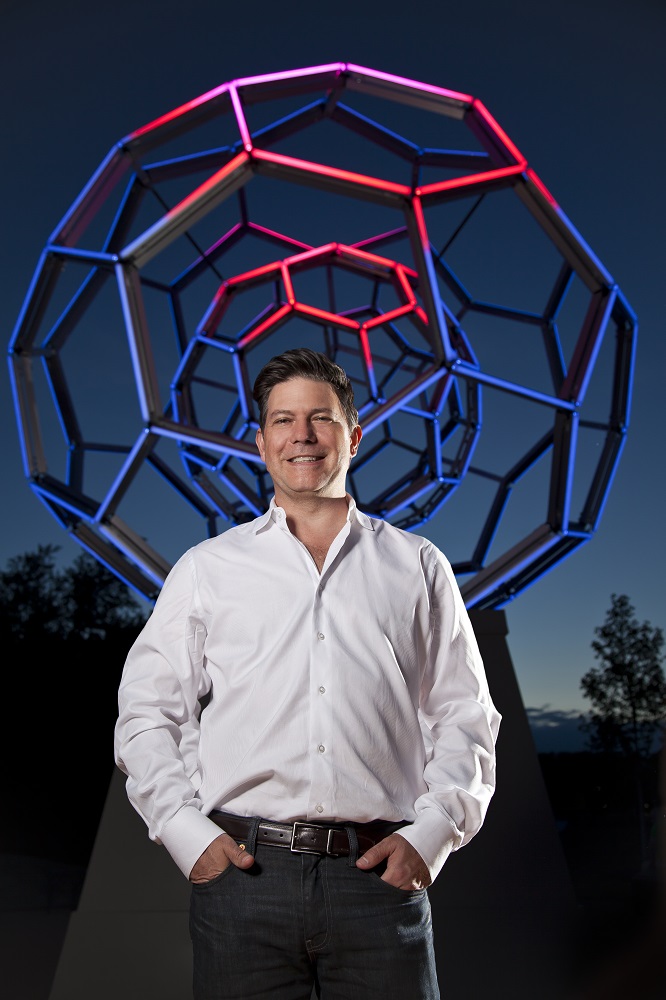
Leo Villareal with Buckyball, Crystal Bridges Museum of American Art, Bentonville, Arkansas. Photo by Dero Sanford.
Happy Birthday to Leo Villareal, the creator of the Buckyball– the spherical sculpture that lights up the path to our front entrance at dusk.
Buckyball consists of two geodesic spheres, one ten and one twenty feet in diameter. (“Geodesic” is a geometrical term pertaining to the shortest line between two points on a sphere.) Each sphere in this sculpture features 180 LED tubes arranged in a series of 12 pentagons and 20 hexagons. Its shape is known as a “Fullerene,” first identified by scientists in the 1970s as a naturally occurring molecular shape in the form of a sphere. This shape pays homage to designer and innovator R. Buckminster Fuller whose geodesic domes it resembles. Spherical Fullerenes are called “buckyballs,” combining his name with the soccer-ball-like shape.

A model of a Carbon 60 molecule, the Fullerene upon which Villareal designed his Buckyball sculpture
A 3D model of a en:C60 molecule, also called a “Buckyball”. Created by Michael Ströck
In our installation of Buckyball, viewers are bathed in a radiant glow as the light changes. Colors shift in patterns of randomized order. Nestled near the entrance to our museum grounds, it can be a celebratory or meditative experience, inviting the viewer to think about the nature of life in a technology-filled environment. It was previously on view at Madison Square Park in New York City.
“Buckyball affirms the power of public art to connect people and to create communal experiences all can enjoy,” said Villareal. The sentiment that inspired the work’s creation fits in with our mission at Crystal Bridges. We welcome all to celebrate the American spirit in a setting that unites the power of art with the beauty of nature, and Villareal’s sculpture does just that.
Crystal Bridges’ collection includes several other examples of light sculptures, such as Dan Flavin’s Untitled (to Mr. and Mrs. Thomas Inch), located at the south end of our 1940s to Now Gallery, and James Turrell’s The Way of Color Skyspace, an immersive light experience installed along the Art Trail.
Villareal has created site-specific works across the globe. This year, his birthday should be extra special—as only two months ago the Illuminated River Foundation chose his work Current to light up London’s 17 bridges spanning the River Thames. The project will be installed next year, and will remain on the bridges permanently.

A computer-generated image of The Illuminated River (Image: © Leo Villareal and Lifschutz Davidson Sandilands)
The design will be the largest public art exhibition in the city’s history. Sensors monitor the motion of the river—such as high tide and low tide—and send that data back to Villareal’s computer program. The light display on the bridges will change depending on the tide. It will also change from bridge to bridge in order to highlight the unique architecture of each structure.
Born in the 1960s, Villareal was one of the first generation of artists to come of age at the same time as personal computers. Although light is the visual output of his work, his true material is computer coding. The moving lights are sequenced patterns using mathematical formulas. The resulting forms move, change, interact, growing into complex organisms that are inspired by mathematical modeling.
For more information, check out:
Leo Villareal. Mad. Sq. Art. New York: Madison Square Park Conservancy, 2012.
Light Show. Cambridge: MIT Press, 2013.
Northrup, JoAnne. Leo Villareal. San Jose: San Jose Museum of Art, Hatje Cantz, 2010.
Shea, Christopher D. “British-American Team Is Chosen to Light Up London’s Bridges.” New York Times. December 8, 2016. https://www.nytimes.com/2016/12/08/arts/design/british-american-team-is-chosen-to-light-up-londons-bridges.html
Springer, Kate. “Painting with light on London’s river Thames.” CNN. December 19, 2016. http://www.cnn.com/2016/12/19/architecture/london-illuminated-city-river-thames-london/index.html
Villareal, Leo. http://villareal.net/



